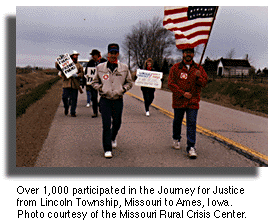|
12 Points Proposed for Governing
Concentrated Animal Feeding Operations
A Brief Summary
Missouri Rural Crisis Center
and the Ozark Chapter of the Sierra Club
 As part of their National Campaign for Family Farms and the Environment, the Missouri Rural Crisis Center (Agricultural Policy Task Force) in conjunction with the Ozark Chapter of the Sierra Club drew up the following 12-point proposal to control "concentrated animal feeding operations (CAFO)." As part of their National Campaign for Family Farms and the Environment, the Missouri Rural Crisis Center (Agricultural Policy Task Force) in conjunction with the Ozark Chapter of the Sierra Club drew up the following 12-point proposal to control "concentrated animal feeding operations (CAFO)."
1. Public Notice and Request for Public Hearing: Notification of intent to construct or expand a CAFO to more than 600 animal units must be published in the local newspaper and sent to neighbors, the County Commission and the water supply district. If requested by petition of 15% of the township residents, there must be a hearing.
2. Financial Assurance Instruments: There must be a bond posted for closure and clean-up in any lagoon with more than 5 million gallons capacity.
3. Sewage Treatment Facilities: For wet-handling facilities with over 7000 animal units, there must be an aerated sewage treatment plant which complies with all regulations governing such.
4. Sensitive Watersheds: No facilities with more than 600 animal units shall be located within the watershed of a public drinking water supply lake or river or critical habitat waters. The Clean Water Commission shall adopt rules to eliminate threats to water.
5. Air quality: CAFOs shall not exceed emissions of substances, compounds or odors regulated by the state or federal Clean Air Acts or Clean Air Act Amendments of 1990. The Missouri Air Conservation Commission shall establish standards. Aerial spraying of waste is prohibited.
6. Reporting: Failure to report a discharge to streams, rivers or lakes shall be cause for immediate revocation of all permits and immediate cessation of operations.
7. Neighboring Properties: No CAFO shall be located within one and one-half miles of an existing residence unless the owner of the facility compensates the owner of the residence and associated lands for loss of property value. No Class 1A facility shall be sited within 5 miles of state parks or Conservation land.
8. Lagoon Construction: Lagoons are to be containerized with liners on top of compacted clay.
9. Berms: Berms in drainages shall be constructed with a drain that can be opened when application is not occurring. Water quality will be monitored pre and post-application.
10. Groundwater Monitoring: Monitoring wells shall be installed around the perimeters of all wet-handling facilities with more than 600 animal units. The number and location of wells shall be determined by professional hydro-geologists.
11. Animal Carcasses: Disposal of animal carcasses, body parts, placentas and fetuses into waste lagoons shall be cause for revocation of all permits.
12. University of Missouri Commercial Agriculture Program: One-half of the annual budget shall be assigned to activities promoting sustainable agriculture in the state.
|



 As part of their National Campaign for Family Farms and the Environment, the Missouri Rural Crisis Center (Agricultural Policy Task Force) in conjunction with the Ozark Chapter of the Sierra Club drew up the following 12-point proposal to control "concentrated animal feeding operations (CAFO)."
As part of their National Campaign for Family Farms and the Environment, the Missouri Rural Crisis Center (Agricultural Policy Task Force) in conjunction with the Ozark Chapter of the Sierra Club drew up the following 12-point proposal to control "concentrated animal feeding operations (CAFO)."